Intel launches 18 new 14th-Gen Raptor Lake Refresh processors – new locked 65W and T-Series 35W chips are available now
Locked processors firm up Intel’s stack.

Intel announced 18 new Raptor Lake Refresh chips today, with the new 65W and 35W models firming up the company’s product stack from the Core i3 models up to Core i9. The higher-end processors square off with AMD’s potent Ryzen 7000 series, but they’ll eventually face off with AMD’s next-gen Zen 5 models. Meanwhile, the lower-end models will contend with AMD's new models for the AM4 platform.
Intel claims the higher-end Raptor Lake models offer up to 37% more multi-threaded performance than the prior generation. The $549 24-core 32-thread Core i9-14900 slots in as the flagship of the 65W lineup, while the lower-power variant of that same chip, the Core i9-14900T, slots in as the headliner for the 35W lineup of T-Series processors. The lineup extends down to the $82 dual-core quad-thread Intel Processor 300, with plenty of options interspersed between the high- and low-end offerings. The processors are available today at all major retailers worldwide.



As with the higher-end K-Series models that Intel introduced last year, the lower-power models feature the Raptor Lake Refresh design etched on the ‘Intel 7’ process node. As the codename implies, Intel’s newest chips are a refreshed version of the 13th-Gen Raptor Lake processors that debuted in 2022. While Intel's refresh generation doesn’t provide the big gen-on-gen leaps we would typically see with new core microarchitectures, Intel did optimize its chips to try to make them more attractive. You can read more about the general architecture in our Core i9-14900K, i7-14700K and i5-14600K review.
As with their K-Series predecessors, the new models drop into Intel’s 600- and 700-series motherboards, offering plenty of options for builders. The chips have all of the features of the more powerful models, like support for up to 192GB of DDR5-5600/DDR4-3200 memory. (Notably, the Core i5 and lower models only support a peak of DDR5-4800.) The ability to select DDR4 memory helps lower the cost for builds, but the lower-end models will square off with AMD's new models for the AM4 platform that also supports DDR4, providing plenty of healthy price competition on the low end.
The chips also support the same PCIe 5.0/4.0 lane allocations as the prior-gen models, along with the other connectivity options, like USB 3.2 with up to 20 Gbps transfer rates.
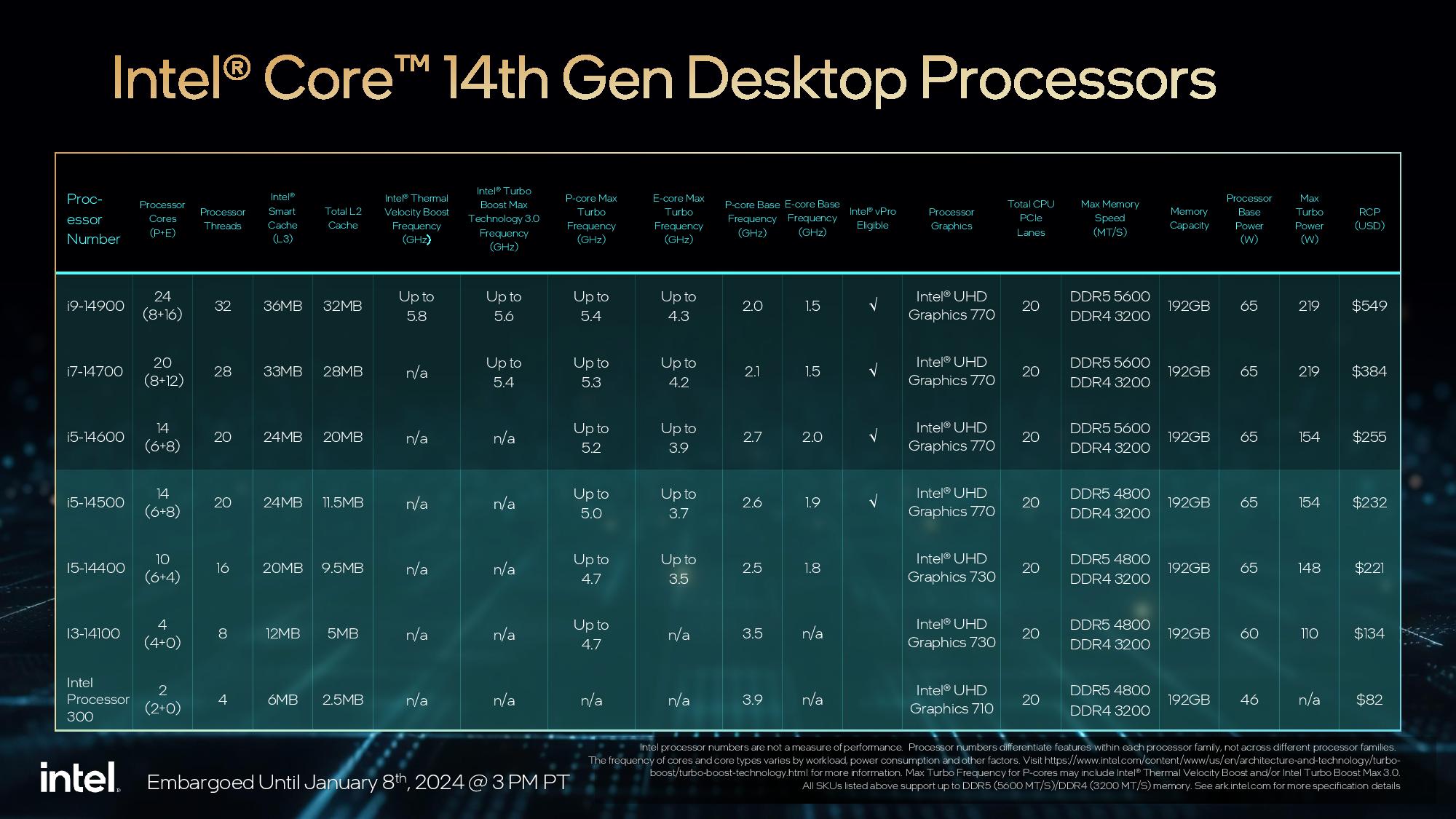
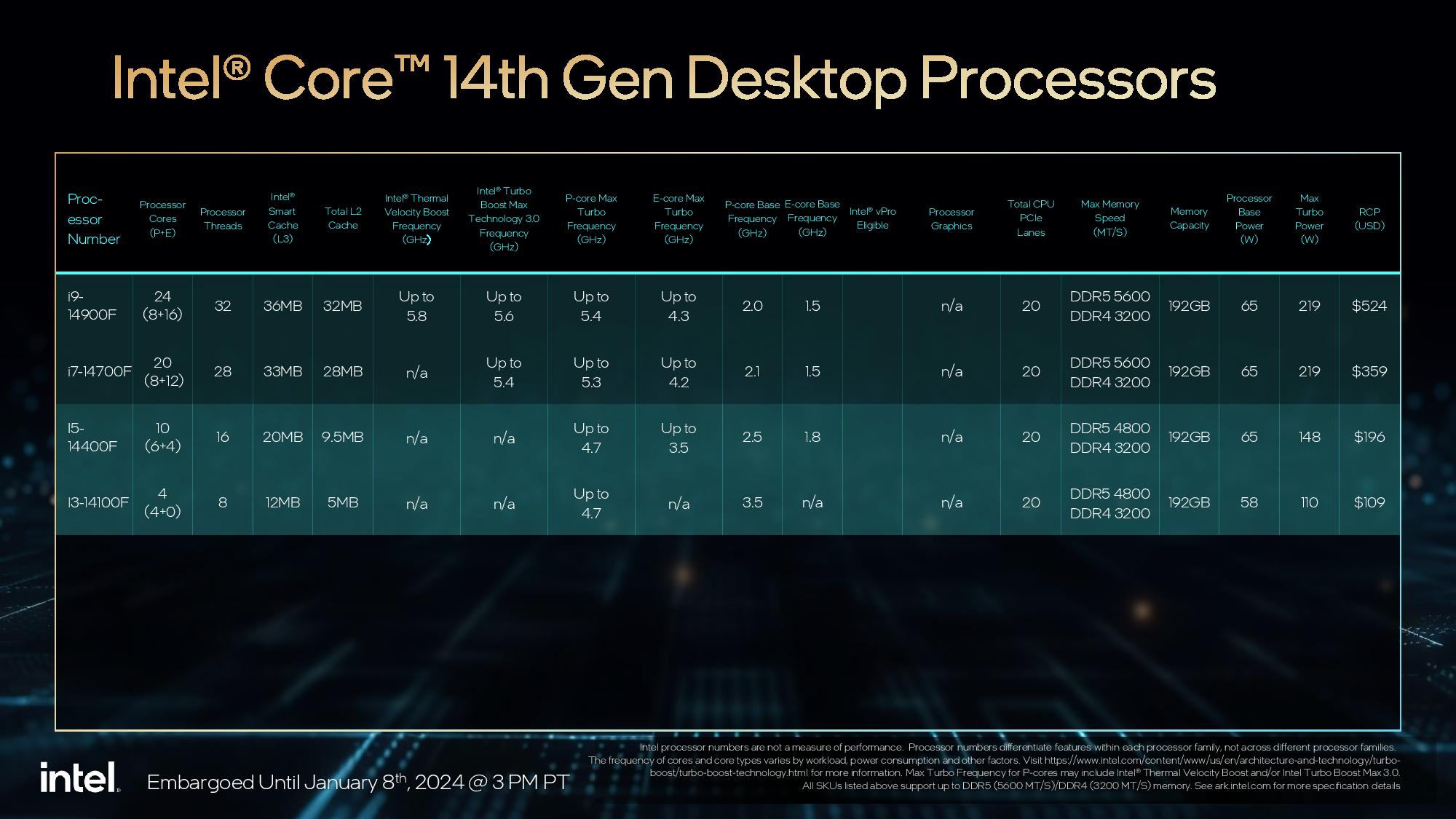
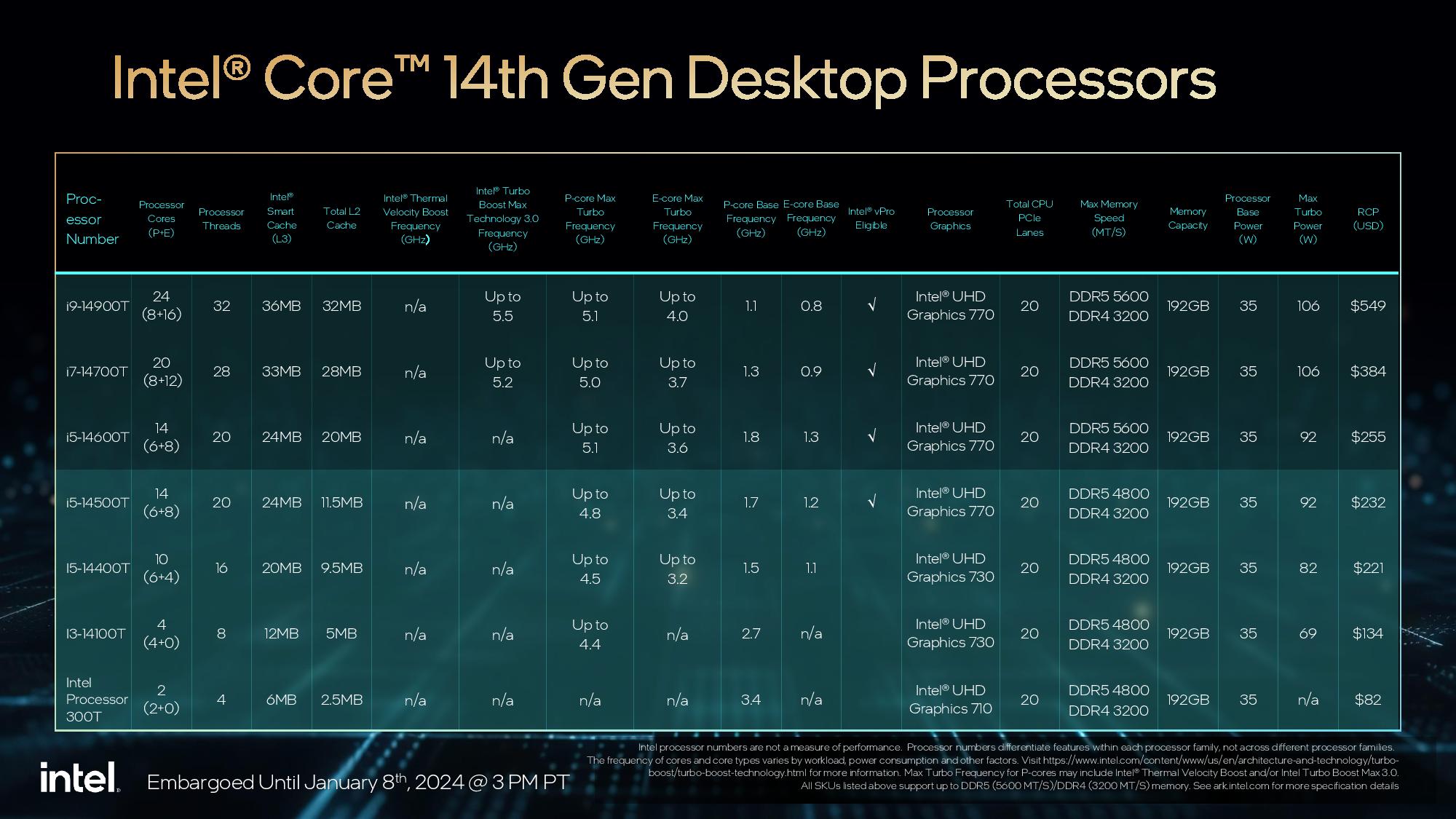
These are Intel’s lower-power models, so you’ll want to pair the lesser chips with more affordable B- and H-series motherboards. Intel also throws in a bundled Laminar RM1 cooler with all 65W and 35W processors. As before, you can opt for graphics-less F-series models to save about $25, but Intel only has four of those models available.
Aside from minor clock speed improvements, the new product stack largely mirrors the previous-gen models with comparable core counts and cache allocations. The Core i7-14700 model stands out as the only option with more cores than its predecessor. This chip has four more e-cores than the prior-gen model, bringing it to 12.
Get Tom's Hardware's best news and in-depth reviews, straight to your inbox.
Intel’s mid-range Core i5 processors tend to be the most attractive to gamers. Still, the Core i5-14400, which tends to be the sweet spot, is emblematic of the small gains we see across the product stack: It only has a marginal 100 MHz increase in p-core and 200 MHz in e-core boost clocks to tout as an improvement. That isn’t going to make this a meaningful jump forward over the prior-gen, so we suspect that savvy enthusiasts will take advantage of the inevitable price drops of the Core i5- 13400 instead of selecting a 14400.
The locked Raptor Lake Refresh models have 65W and 35W processor base power (PBP – TDP) ratings, but the Max Turbo Power (MTP) stretches beyond those ratings, with a peak of 219W with the Core i9-14900. These PBP/MTP values are the same as the previous gen, but that partially restricted Intel's ability to boost clock speeds much higher within the same envelope. Regardless, Intel did squeeze out a few bins of extra frequency across most of the stack.
The Intel Processor 300 weighs in with a mere two cores for $85. These cores run at a fixed 3.9 GHz clock, but the chip surprisingly still carries a unique 48W PBP/MBP.
Intel used a mix of Raptor Lake and Alder Lake dies for its previous-gen Core i5 and i3 models, but this time around, the company only uses Raptor Lake Refresh dies, as outlined here, for Core i5. Intel’s B0 dies come with eight P-cores and 12 E-cores for the Core i9 models, but some of the cores are disabled to create the Core i7 models. Intel also has Raptor Lake Refresh C0 and D0 dies for the Core i5 lineup (details in the above link) and employs an Alder Lake quad-core H0 die for the Core i3 models.
Intel 14th-Gen Raptor Lake Refresh 65W and 35W gaming and productivity benchmarks
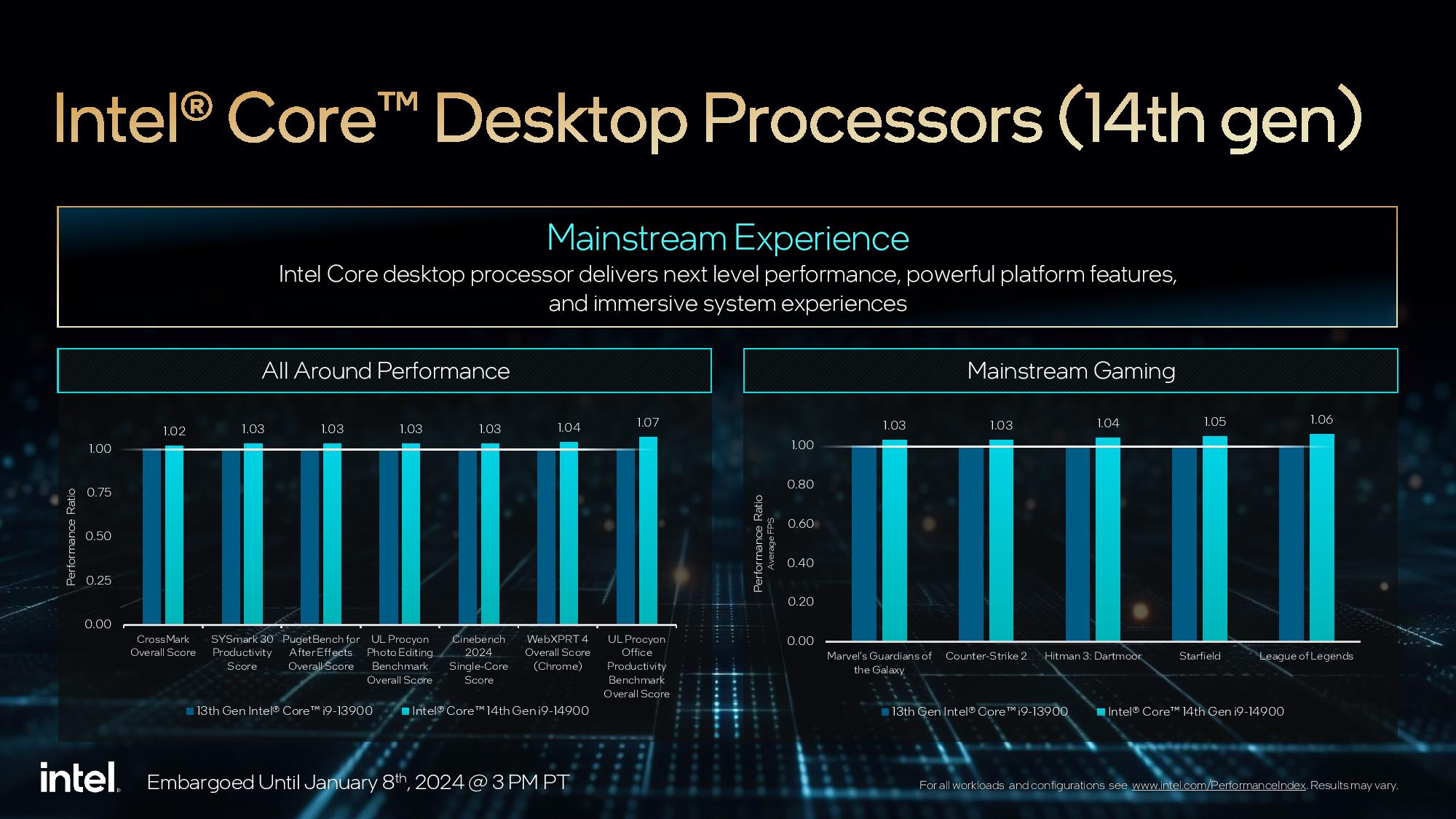
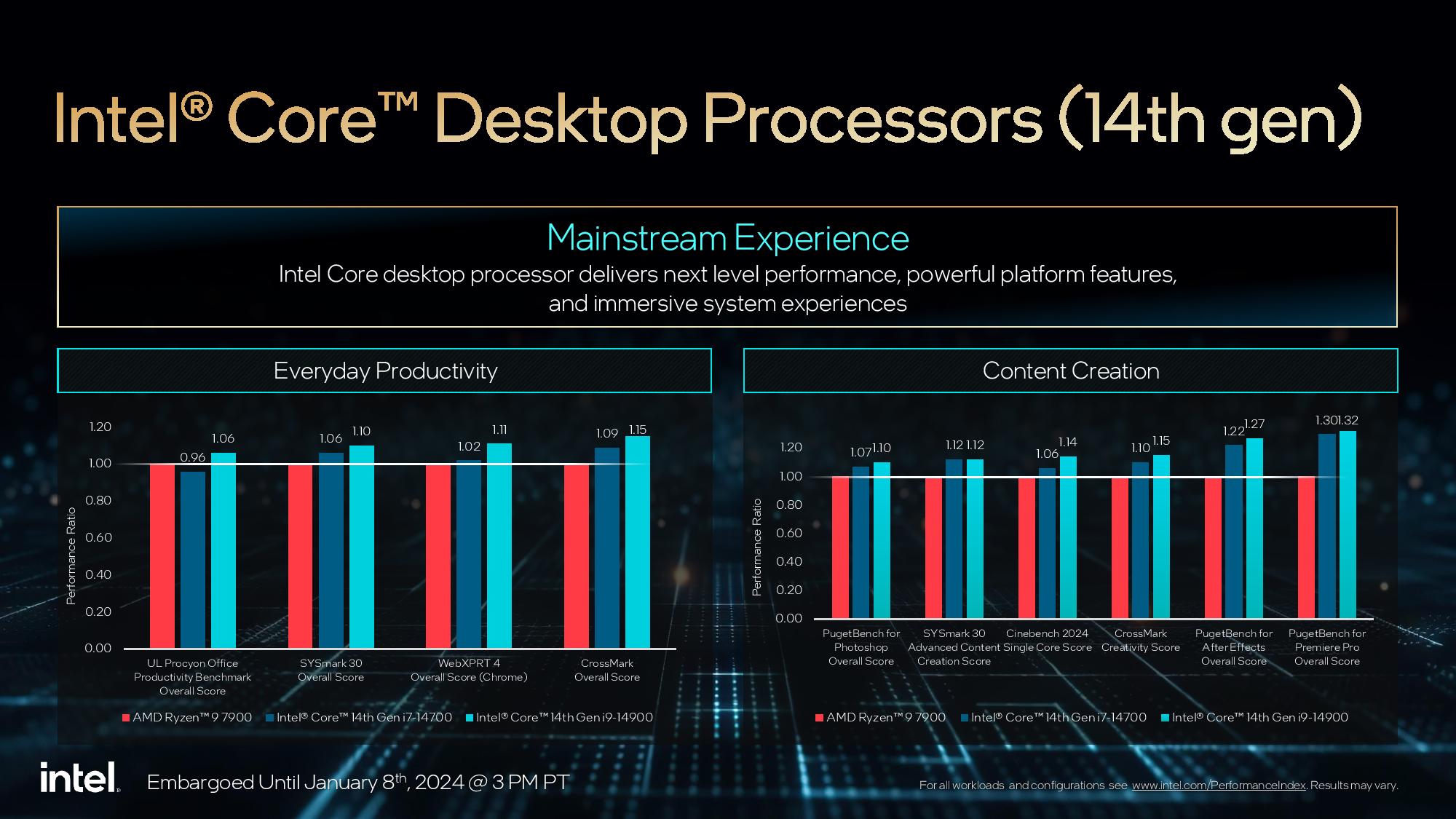
Intel shared its own benchmarks, but as with all vendor-provided results, we should take them with a grain of salt.
That said, there aren’t many benchmarks to chew over. Intel claims slight gen-on-gen improvements over its own prior-gen 13900 across a spate of gaming and productivity benchmarks and highlights larger wins in productivity workloads against AMD’s Ryzen 9 7900. We’ll have to test these chips to render the final verdict, and we have several already headed for the test bench.
Intel is also releasing new China-specific 14th-Gen ‘Black’ SKUs, but those aren’t detailed in today’s release. The mainstream 14th-Gen Raptor Lake Refresh processors are available today at major etailers/retailers, but we see these refresh chips are largely a lateral move that will only deliver slight gains over the prior-gen models.

Paul Alcorn is the Editor-in-Chief for Tom's Hardware US. He also writes news and reviews on CPUs, storage, and enterprise hardware.
-
artk2219 "Locked processors firm up Intel’s stack"Reply
Hah, ah, im a child. That made me laugh far more than it should have.
These chips should definitely allow for some decent general build options, and even though they're not necessarily a huge upgrade over the 13th gen, they're a newer bigger, although not necessarily longer, number. -
HideOut "The higher-end processors square off with AMD’s potent Ryzen 7000 series, but they’ll eventually face off with AMD’s next-gen Zen 5 models. "Reply
Won't intels 15th gen come at nearly the same time likely? So itll be Zen 5 vs 15th gen... -
artk2219 Reply
No, 15th Gen should be coming out towards the end of the year and Zen 5 \ Ryzen 8000 is slated for the first half of the year. So there would be around 3 - 6 months of 14th Gen vs Ryzen 8000 series. That said, these chips mostly aren't high end chips, so they would really be fighting Ryzen 7000 and 8000G series, which is still Zen 4. As always, price will be king in most situations, so they may not always be as fast, but sometimes it's alright if you don't finish first.HideOut said:"The higher-end processors square off with AMD’s potent Ryzen 7000 series, but they’ll eventually face off with AMD’s next-gen Zen 5 models. "
Won't intels 15th gen come at nearly the same time likely? So itll be Zen 5 vs 15th gen... -
microsatacable Intel is really stepping up their game with these 14th-Gen Raptor Lake Refresh processors! The addition of locked 65W and T-Series 35W chips provides more options for users looking for specific power requirements. Can't wait to see the performance benchmarks and how they compare to the previous generation.Reply